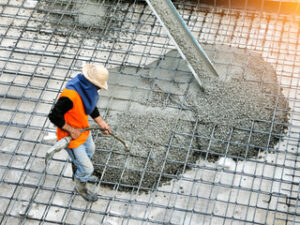Concrete Greensboro NC is one of the most common building materials on the planet. It’s fire resistant, stands up to moisture, and gets even stronger over time.

To make concrete, you need air, water, cement, and aggregates – like sand and gravel. The right proportions of these ingredients create a material that’s strong, durable, and versatile.
Concrete is the most widely used construction material in the world and it is extremely strong. It can withstand heavy loads, especially when combined with steel in the form of reinforced concrete. This makes it the preferred building material for structures that need to bear a lot of weight, such as bridges and skyscrapers. It is also non-combustible and offers good fire resistance, which is important for large buildings. In addition, it can be moulded into many different shapes, making it easy to make custom designs.
The strength of concrete depends on the ratio of cement to aggregate and water. This is why it is very important to use the correct proportions of each ingredient and prevailing environmental conditions when mixing and curing. A slight change in any of these variables can have a significant impact on the final strength of concrete.
There are a number of factors that influence the strength of concrete, including the type and size of aggregates, the amount of cement used, the water/cement ratio (w/c), and the hydration process. The amount of water in the mix is particularly important because it affects both the workability of the concrete and its strength. Higher w/c ratio mixes are easier to work but require more cement to achieve the same strength.
During the mixing and curing processes, concrete experiences a process called hydration that increases its strength. However, this process can be inhibited by high temperatures and poor mixing procedures. Depending on the conditions, it can take up to 28 days for concrete to reach full strength, although it will continue to gain strength at a slower rate for some time afterwards.
When designing concrete structures, engineers must take into account creep deflection. This is a long-term deformation that can be several times larger than the elastic deflection of the structure. It can cause damage to non-structural elements and can lead to unintended load paths.
For this reason, it is important for engineers to use concrete that has a high strength to volume ratio. This will minimize the amount of concrete that is needed to achieve a specific strength, while ensuring that the concrete is strong enough for its intended application.
Durability
Concrete is a durable material that withstands extreme conditions and can be used in various applications. In addition to being highly resistant to abrasion, it can withstand moisture, temperature changes and chemical attacks. However, the durability of concrete depends on a variety of factors, including its mix proportions, admixtures, reinforcement, curing methods, and environmental exposure. Properly managing these factors ensures that structures built with concrete remain strong and resilient over time. Measuring the durability of concrete is a critical step in ensuring that buildings and other structures are safe and reliable. Durable concrete structures require fewer repairs and maintenance costs, which can reduce building expenses and improve resource productivity.
During the construction process, concrete is mixed, poured and compacted to create a hard surface. The strength of the concrete is determined by its ability to resist a certain amount of pressure. This is measured using tests such as the rebound hammer and the ultrasonic testing. The rebound hammer measures the force that is exerted on the concrete during compression. It can also be used to measure the concrete’s viscosity and maturity. These tests help engineers to determine the maximum possible strength of the concrete.
It’s crucial to ensure that the concrete used in a structure is high-quality, and the construction site meets industry standards. Inadequate construction techniques can cause structural defects that will lead to premature degradation. It’s also important to regularly inspect concrete structures for signs of wear and tear, so that minor problems can be identified early and addressed promptly.
The most common form of damage to concrete is corrosion of its embedded reinforcing steel, which leads to deterioration and the loss of load-bearing capacity of the structure. This is a serious problem that can cost public and private sectors worldwide billions of dollars in repair and maintenance costs. Durable concrete structures are more resistant to corrosion and can withstand environmental hazards, such as fires, storms and earthquakes.
In order to achieve greater durability, engineers can use a number of different strategies, including the selection of a suitable curing regime, incorporating a range of different admixtures, and establishing a comprehensive monitoring program. In addition, they should ensure that the structure is properly inspected and maintained after construction.
Flexibility
Concrete is one of the most versatile building materials available. It can be used to construct buildings, roads, railways and airports. It can also be used to make pavements and kerbs. It is often the preferred construction material for commercial projects due to its durability and versatility. Moreover, it is cost-effective and can be easily shaped into any desired form.
The basic ingredients of concrete include sand, gravel and crushed rock, which are bound together by a hydraulic binder like Portland cement and activated with water. This produces a semi-homogenous mass that is very strong in compression. For applications that require tensile stress, reinforcement is added to the mixture.
Since its inception, concrete has undergone a number of technological advances that have increased its strength and flexibility. These innovations have allowed engineers to design structures with unprecedented levels of architectural precision and structural integrity. This has enabled concrete to become the kingpin of mega projects such as airports, railway stations and sky-rise multi-storeys. Concrete can also withstand unlimited heavy loads, making it the ideal choice for transport infrastructure.
In addition to its versatility, concrete offers many environmental benefits. Its long lifespan reduces the need for frequent reconstruction and maintenance, saving resources and reducing energy demands. Furthermore, the thermal mass properties of concrete can help regulate indoor temperatures, reducing energy demand and emissions. Additionally, concrete can be used to construct green buildings, including those with recycled and renewable materials.
Despite its popularity and widespread use, concrete is not without its drawbacks. Waste and inefficiencies associated with the production of concrete can lead to significant environmental impacts. Up to 40% of the concrete used in a project can be left unused, which leads to high disposal costs.
To improve efficiency and reduce waste, concrete companies are adopting new technologies to increase the durability of concrete and reduce its reliance on fossil fuels. For example, some manufacturers are incorporating fly ash and other industrial byproducts into their concrete mixtures to save energy and reduce carbon emissions. This technology has already been adopted by several construction firms and is expected to have a substantial impact on the industry’s sustainability performance.
Cost
Concrete has a reputation for being boring and plain, but this material can be used to create architectural features that are both beautiful and functional. Decorative techniques such as stamping, staining and polishing can make concrete look like other materials, such as stone or wood. It can also be molded into various shapes and textures to create unique design elements. In addition, concrete is a durable building material that requires little maintenance. Moreover, it is a more affordable option than steel.
Concrete is one of the most widely used construction materials in the world. It is used to build buildings, sidewalks, roads, and even dams. Its versatility makes it a popular choice for commercial and residential buildings, because it is durable, energy-efficient, and provides a sound foundation for structures. Concrete is also environmentally friendly, as it does not release VOCs (volatile organic compounds) into the air. This is especially important in homes and businesses, where airborne allergens can trigger allergies and respiratory problems.
The cost of concrete varies depending on the type of project and the type of ingredients. Traditional concrete is a mix of water, cement, and aggregate, which is then poured into place and allowed to harden. It is often mixed on site, but it can be precast in a plant before being transported to the construction site. This can help reduce costs and speed up construction time.
Another factor that affects the cost of concrete is labor. Concrete is easy to work with, but it still takes skilled workers to shape and position it. This is especially true for projects that require detailed forms or curved surfaces. Other factors that can increase the cost of concrete include weather-related delays and construction permit fees.
While the initial cost of concrete is low, it can quickly add up when multiple components are added to the mix. For example, a building made of concrete may need to be reinforced with steel or other materials to support the structure and prevent it from collapsing. In addition, concrete can be made more durable by adding fibers or other additives.

